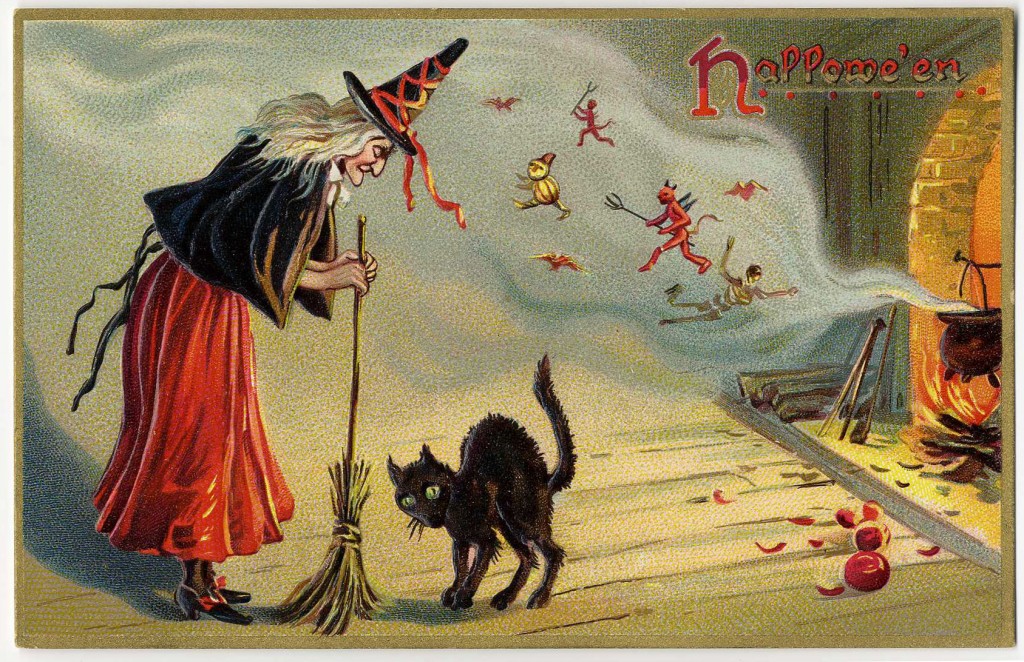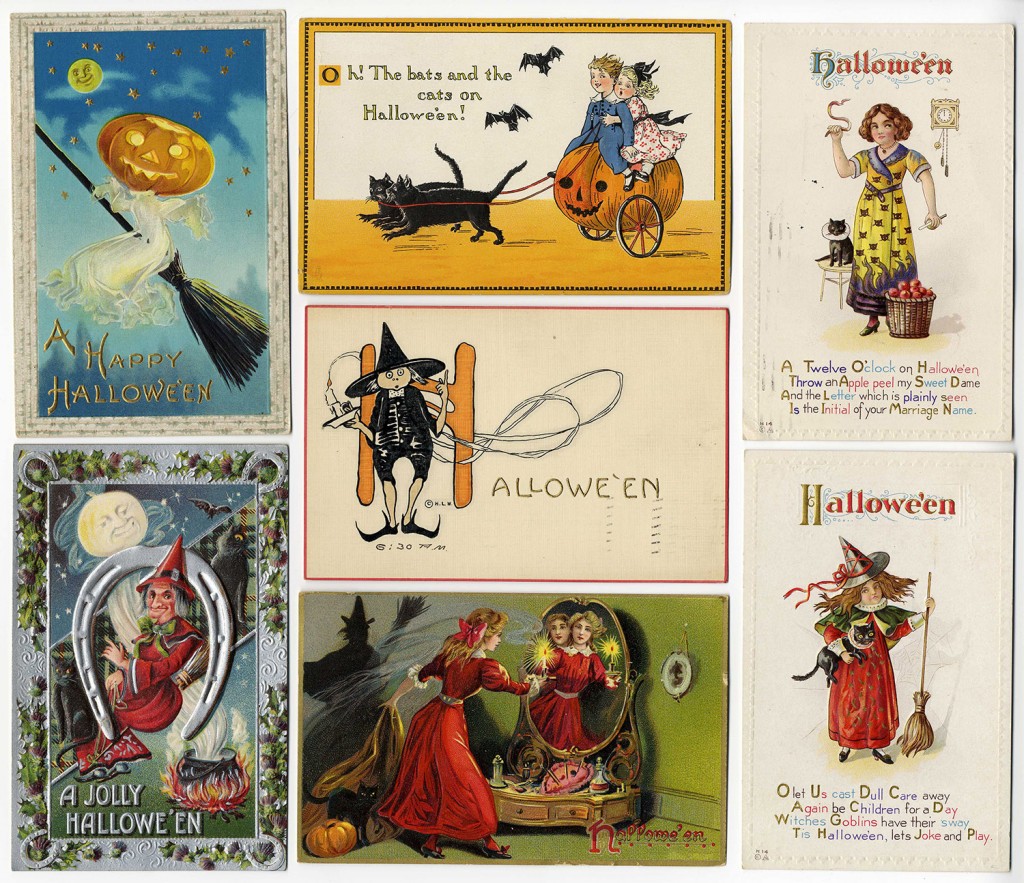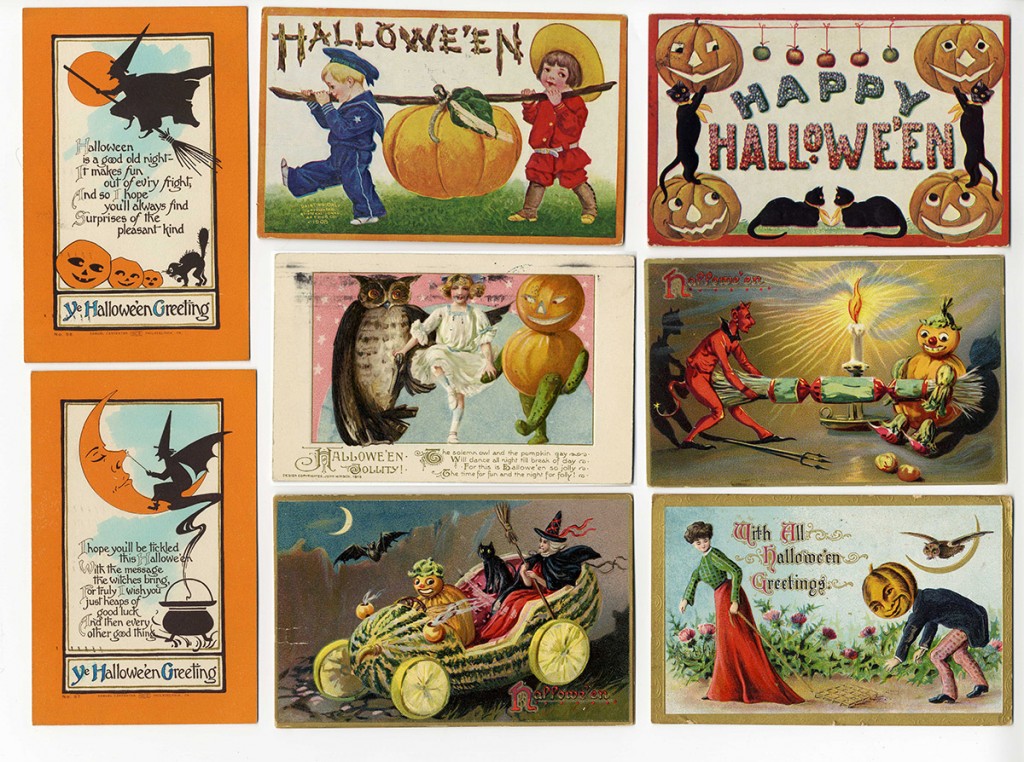 In the same vein as last year’s ghostly stereocards blog post, we offer another Halloween treat for you! Have you thought about sending someone a light-fright this October? If you’ve been in any stationary or card aisle recently, you would notice most holidays serve as an excuse to send a greeting. Although conservative in number (sixteen unique; seventeen in total), the AAS collection of Halloween postcards documents another era of this fad. Many are between members of the Weir Family of Worcester, Mass., dated 1910-1913. Here, the fronts and backs (including some charming drawings of pumpkins) have been digitized and linked in our digital image archive, GIGI.
In the same vein as last year’s ghostly stereocards blog post, we offer another Halloween treat for you! Have you thought about sending someone a light-fright this October? If you’ve been in any stationary or card aisle recently, you would notice most holidays serve as an excuse to send a greeting. Although conservative in number (sixteen unique; seventeen in total), the AAS collection of Halloween postcards documents another era of this fad. Many are between members of the Weir Family of Worcester, Mass., dated 1910-1913. Here, the fronts and backs (including some charming drawings of pumpkins) have been digitized and linked in our digital image archive, GIGI.
These postcards illustrate a snapshot in time between Halloween as a belief in spirit possession (i.e. the All Hallows Eve events) and the costumed-candy-revels of the twenty-first century. In  these images, participants are no longer attempting to frighten roving souls, but rather join them. The cards are more than just pretty images of youthful flirtation with the spirit world; they also have historical depth.
these images, participants are no longer attempting to frighten roving souls, but rather join them. The cards are more than just pretty images of youthful flirtation with the spirit world; they also have historical depth.
The postcards are representative of what Daniel Gifford, author of American Holiday Postcards, 1905-1915 (2013), refers to as the cards’ Golden Age. The Society’s collection is American, British, and German in origin. Gifford describes the international exchange of these objects, which was disrupted by World War I when the printing and import of cards from Germany ended. In the Society’s collection are several beautiful German examples – “A Jolly Halloween,” “With All Halloween Greetings,” and the hand-embossed “Halloween” postcard by the firm H. L. Woehler. The choice of Halloween lends itself to the riches of color printing; the holiday, paired with autumnal festivals and harvests, provides a bountiful palette of colors, including reds, gold, oranges, blues, blacks, and greens.
 The picture postcard, as historian David Henkin puts it in his text The Postal Age (2006), shows a “traveler’s implicit claim to have encountered scenes of interest” (Henkin 129-30). Without a doubt, holiday postcards are an entirely different animal from picture postcards (for interested readers, Gifford’s monograph does include a treatment specifically of these holiday postcards). Likely no one sending a Halloween postcard encountered a witch, devil, goblin, or ghost, but these images offered the opportunity for the creator to explore these subjects visually (subjects the sender/recipient might hope to encounter only in print!).
The picture postcard, as historian David Henkin puts it in his text The Postal Age (2006), shows a “traveler’s implicit claim to have encountered scenes of interest” (Henkin 129-30). Without a doubt, holiday postcards are an entirely different animal from picture postcards (for interested readers, Gifford’s monograph does include a treatment specifically of these holiday postcards). Likely no one sending a Halloween postcard encountered a witch, devil, goblin, or ghost, but these images offered the opportunity for the creator to explore these subjects visually (subjects the sender/recipient might hope to encounter only in print!).
In his article “Star-Spangled Turkeys” Gifford states, “at the peak of their popularity billions of postcards were circulating through post office networks of kin and friends, and into boxes and albums” (Gifford 14). Since the AAS collection of uncatalogued postcards includes both picture postcards and holiday pieces interfiled together, it allows us to study one small network in action as we can see through the grouping how they were selected, sent, received, and ultimately collected.
The Society’s collection of postcards is an area of the Graphic Arts Collection that extends beyond the 1876 cutoff date (how devilish!). So be sure to browse the digitized cards to send something spook-tacular to someone who might like a Halloween greeting! They’re so beautiful, it’s almost scary!
Works Cited
Gifford, Daniel. American Holiday Postcards, 1905-1915: Imagery and Context. Jefferson, North Carolina: McFarland & Company, Inc., Publishers, 2013.
—. “Star-spangled Turkeys: Patriotism in Thanksgiving Postcards.” Ephemera Journal. Sept 2014, 17:1, 14-18.
Henkin, David M. The Postal Age: The Emergence of Modern Communications in Nineteenth-Century America. Chicago: University Of Chicago Press, 2006.

2 thoughts on “Under Their spell: The AAS Collection of Halloween Postcards”